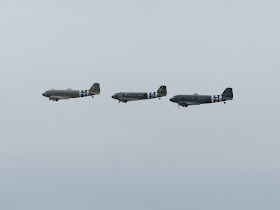We rarely post about garden captures, after all it's difficult to get excited about Blue Tits and Great Tits. We're even less excited about the Starlings that we manage to catch in the ground trap from time to time.
So, we had a net for larger birds up today, in the hope that we may catch another of the Jackdaws that have been dropping in an taking away scraps. We'd already caught one but they tend not to stay in the usual 16*16 mesh net.
When the Jackdaw arrived it landed by the net, took a good, long look then deftly hopped over, grabbed food and flew off with a beak full of meat scraps. The Jay and Magpies didn't put in an appearance. There was however an unexpected bonus.
Not one, but two Red Kites swooped in and were held. They became the first REDKI ringed by Runnymede Ringing Group.
We only got these two birds because we were trying for another of these!
A round up of our bird ringing activities (all birds ringed under licence from the British Trust for Ornithology with schedule one authority where appropriate), birding trips and other wildlife sorties within the UK and whenever we get chance, elsewhere.
Saturday, 15 June 2019
Friday, 7 June 2019
Norfolk 5th & 6th June 2019
The visit was primarily for Chris' mum's 90th on the 5th, but we travelled up on the 4th via the Daks at Duxford event in commemoration of the D-day landings
5th June.
The morning of the 5th we meet the warden of a Norfolk reserve and were taken to an area that had probably been colonised by Scarce Blue-tailed Damselflies in the last few years, possibly from Europe rather than from the UK. The weather was not great, a bit overcast but windy. We did find a few thankfully at what was a very interesting site.
Azure Damselfly
Blue-tailed Damselfly
Hairy Dragonfly
Keeled Skimmer
Scarce Blue-tailed Damselfly
As we had a spare couple of hours before the gathering at the care home, we made a visit to the new scrape that had been made just east of Wells-next-to-sea, which seem to have been readily adopted 40 or so Avocets there with young, Lapwings, Redshank and even feeding Spoonbills. A single Greenshank was present, along with Marsh Harrier and Red Kite passing over bringing a pretty aggressive response mainly from the Avocets.
Spoonbill
Little Egret
Avocet, adult above and juvenile below
6th June.
As it was a sunnier and less windy day we made a repeat visit to yesterdays Scarce Blue-tail site and had much better photographic results and walked another area that also produced some good dragonfly results.
Scarce Blue-tailed Damselfly - female above, male below
Four-spotted Chaser
Large Red Damselfly male & female
Keeled Skimmer
Broad-bodied Chaser
On the way back south we stopped off at Fordham, which provide a very good site for Scarce Chaser with a single Variable Damselfly seen as well.
Blue-tailed Damselfly
Sunday, 2 June 2019
Stanwell Moor - 1st June 2019
We started the day with ideas of where to put nets in addition to the three above water in the reed-bed and two on the track. These five were all in place quite quickly. We are very careful about covering too broad an area since fishermen have access along the river that boarders the site and there have always been trespassing issues along the path by the river, although increased operations at the recycling plant seem to have deterred most other than a few dog walkers and bored boxless kids in the school holidays.
The site foreman stopped by while patrolling the site so I went to look at the reed-bed nets before doing anything else. It was disturbing to find a khaki-clad figure standing at the end of our net. I asked ' Can I help you?' only to find, as he turned round, that he was holding a Reed Warbler with the netting still attached and a pair of scissors. 'Why are these birds in a net?' was answered by ' I monitor the birds here on behalf of the land owners, give me that bird because you don't know what you're doing, you could injure it and that is a very expensive net you just cut into'. ' How am I supposed to know that?' drew the response, 'This is a private site, you shouldn't even be here. What do you think you're doing?'There was plenty more I wanted to say, but at that point he decided to leg it down the ride and into the Willow carr!
At least he won't be cutting our nets with these again.
Who takes a pair of scissors out on a walk anyway?
Thankfully the bird was unscathed. It appeared to be just the one hole in the net. He probably didn't want to get wet feet. Some people just don't read the signs.
Having finally got close enough to Chris to shout what had happened, he went looking for the guy but he could not be found. After that, we stuck at the five nets already up, with a bit of time watching the LRPS from a distance to see whether they might be more than two chicks. We couldn't see any but they are definitely there. and the parents are doing a very good job.

Juvenile Linnet
Totals: 15 (3)
Robin - 1
Blackbird - 2
Song Thrush - 2
Reed Warbler - 1 (3)
Blackcap - 2
Blue Tit - 5
Linnet - 2
The old recycling heaps that were cleared, flattened, resurfaced with topsoil and grassed at the start of 2018 now offer cover to foraging birds and insects alike.
Black-tailed Skimmer
Hairy Dragonfly
Emperor Dragonfly
Small Heath
Common Blue
Holly Blue
Gatekeeper





































